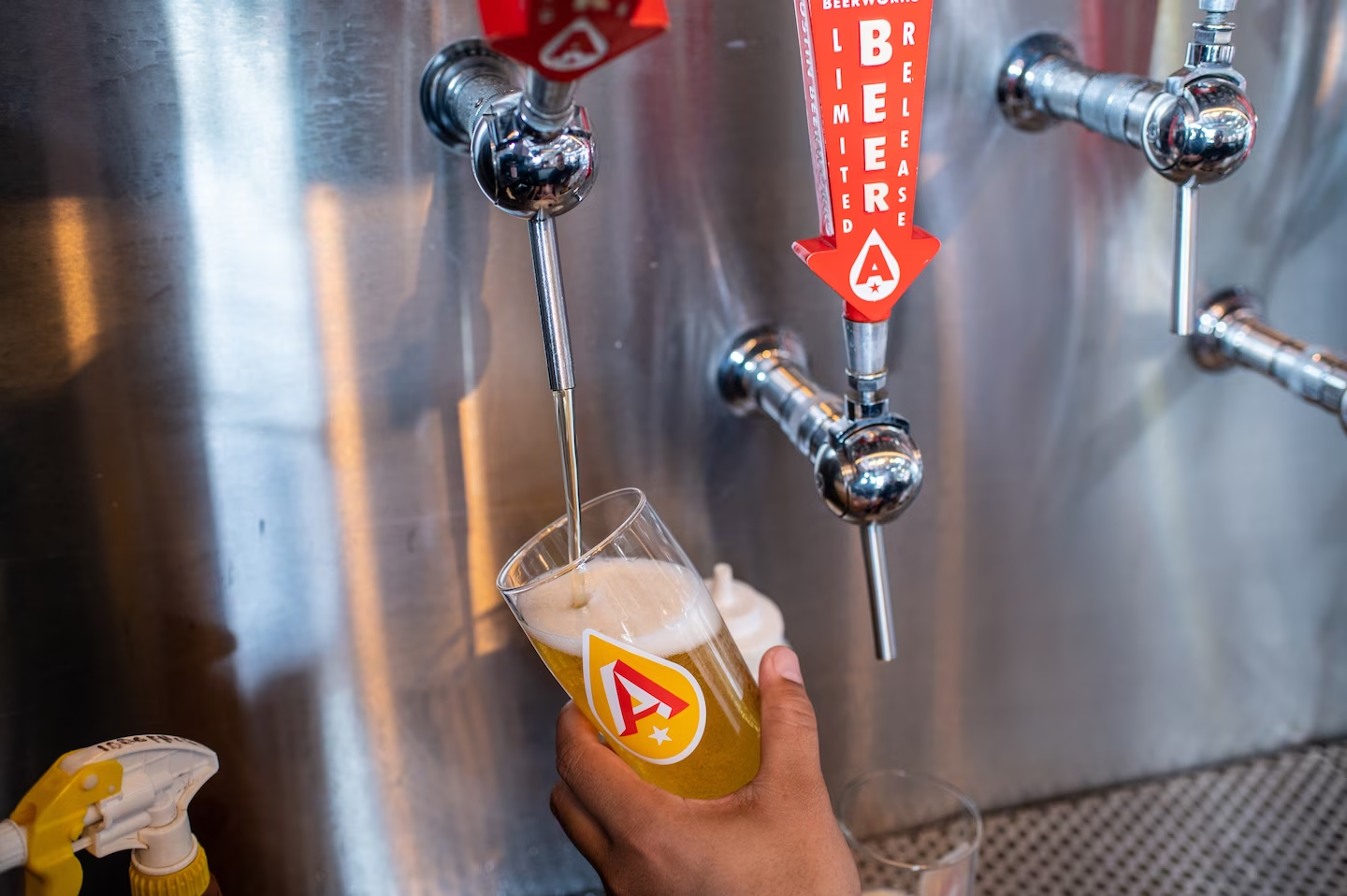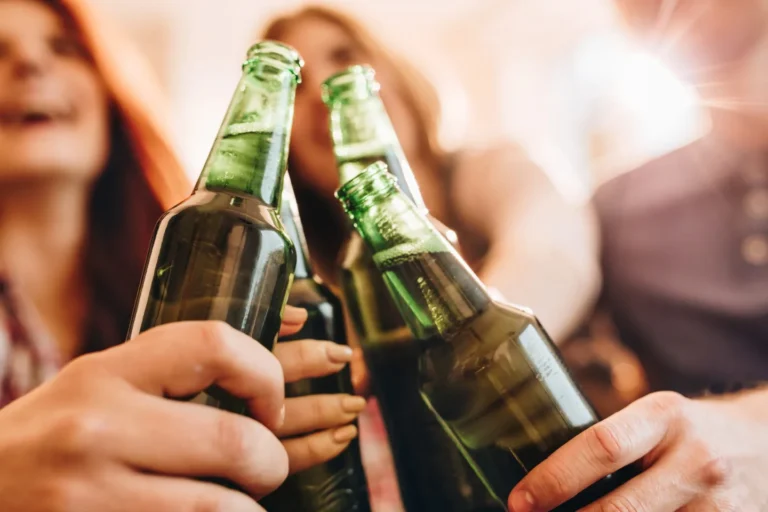AUSTIN — The fresh, doughy aroma around the conical fermentation tanks at Austin Beerworks is a sign that trillions of yeast cells are turning the sugary, hoppy liquid inside into beer.
But there’s another byproduct: carbon dioxide.
Fermentation releases CO2 as the yeast breaks down sugar to create alcohol. At most wineries and breweries, it is released into the atmosphere. But a growing number of craft breweries are starting to collect that gas, not only reducing CO2 emissions — even if by tiny amounts — but also reusing it to give beer its characteristic white foam.
Until recently, Clinton Mack, Austin Beerworks’s cellar manager, had to truck in carbon dioxide in tanks 10,000 pounds at a time. But now, he’s using techniques developed by NASA to capture the naturally produced CO2 and dissolve the molecules into his brews.
“The technology isn’t simple,” Mack said, “but it’s, like, why aren’t we using it?”

Until recently, Austin Beerworks cellar manager Clinton Mack had to truck in carbon dioxide in tanks 10,000 pounds at a time. But now, he’s capturing the naturally produced CO2 and dissolving the molecules into his brews. (Sergio Flores for The Washington Post)

A beer is poured at Austin Beerworks. With the help of a machine called CiCi, the brewery aims to lessen its carbon footprint by recycling CO2. (Sergio Flores for The Washington Post)

Patrons at Austin Beerworks. (Sergio Flores for The Washington Post)
Carbon capture for beer
The machine that enables Mack to capture CO2 from Austin Beerworks’ tanks is the size of a large, double-door refrigerator. Nicknamed CiCi — short for “carbon capture” — it takes in CO2 that flows from the fermenters through pipes that snake around the brewery, filters it to more than 99 percent purity, and condenses it into liquid.
The machine then stores the resulting condensed gas for use elsewhere, including to carbonate beer. Mack said installing the technology, made by Austin-based Earthly Labs, was a no-brainer. The average batch releases about one-third of a pound of CO2 per gallon of beer, which adds up to about 210,800 pounds a year from a brewery like Austin Beerworks. That’s about the same amount of CO2 that 21 gas-powered cars release in an average year.
But while preventing fermentation emissions from being released into the air is a plus, Mack said, it’s also a cost-saving measure for the brewery.
CO2 itself is a valuable ingredient in beer production. The fizzy white bubbles on your favorite Super Bowl commercials are, technically, carbon emissions. Enjoy a can or bottle of beer? CO2 was probably used to package it. Prefer beer on tap? Your neighborhood bar uses CO2 pressure to push beer from a keg into your glass.
And more brewers are trying to find new ways to use the gas they already produce to save money, says Chuck Skypeck, the technical brewing projects director for the Brewers Association, the trade association for independent breweries in the United States.

Mel Stand pours hops into a tank at Austin Beerworks. (Sergio Flores for The Washington Post)

On the left, a hose takes CO2 from a fermentation tank to CiCi. On the right, a fermentation tank releases CO2 into a water bucket at Austin Beerworks. (Sergio Flores for The Washington Post)

Fermentation tanks at Austin Beerworks. (Sergio Flores for The Washington Post)
The cost of all major brewing ingredients — including CO2 — has outpaced the consumer price of beer, he said. “CO2 isn’t just a process element in beer, it’s an ingredient,” Skypeck said. “It’s so critical.”
Brad Farbstein is in the process of adding Earthly Labs’ tech to his brewery in Blanco, Tex., about an hour’s drive west of Austin. He hopes to cut Real Ale Brewing’s CO2 purchasing in half by midyear, and stop buying commercial CO2 entirely by the end of 2023.
The Food and Drug Administration regulates the purity levels of CO2 used in beverages such as beer and soda, but it can come from a variety of sources. Most beverage-grade CO2 is a byproduct of the chemical industry, including from the production of ethanol, natural gas and fertilizer.
“It’s good to get our fingers out of the petroleum industry any way we can,” Farbstein said.

Water in a bucket bubbles as excess CO2 is released at Austin Beerworks. (Sergio Flores for The Washington Post)
How does it work?
The technology these brewers are using was first developed at NASA’s Johnson Space Center in Houston. Since the Apollo era, NASA scientists at its In-Situ Resource Utilization unit have studied how to generate resources for humans to live and work in extraterrestrial environments, such as the moon and Mars.
To allow future astronauts to breathe on Mars, for example, engineers built a system to capture the CO2-rich Martian atmosphere, clean it and create breathable air by stripping the carbon. NASA then licensed the technology to companies that could adapt it for use on Earth.
One of those companies was Earthly Labs, which first tried to deploy it to scrub the air in homes or near large, commercial boilers.
It was while collecting data from a large boiler at another Austin brewery that Amy George, Earthly Labs’ president, saw bubbling fermentation at work. CO2 recapture technology was already available, especially for huge corporations such as AB InBev and Molson Coors, but was too bulky and expensive for most independent brewers.
“Nobody was looking at small-scale capture,” she said.

Clinton Mack, Austin Beerworks’s cellar manager, checks the CiCi machine. (Sergio Flores for The Washington Post)

Piping that bring CO2 from fermentation tanks to CiCi at Austin Beerworks. (Sergio Flores for The Washington Post)

The screen on the CiCi machine. (Sergio Flores for The Washington Post)
CiCi is now in 70 breweries in at least 25 states, the United Kingdom, Canada and New Zealand, with at least 20 more waiting for installation, George said.
Several other companies are producing similar carbon-capture products, including Pentair, a U.K.-based company that works at a larger scale, Hypro Group, which is based in India and has begun selling small units in the United States, and Dalum Beverage Equipment, a Danish company that has been doing small-scale carbon capture in Europe but has recently entered the U.S. market.
But Earthly Labs was among the first companies to make a system that was affordable and scaled down for small brewers in the United States, Skypeck said. A CiCi unit the size of the one at Austin Beerworks, which produces about 620,000 gallons of beer each year, costs $120,000.
The carbon footprint of beer
The promise of carbon-capture technology for beer is small, given the relatively tinyamounts of CO2 released during fermentation. And unless breweries are using renewable energy, running the CiCi machine, which is powered by electricity, generates additional emissions.
Mark Jacobson, director of Stanford University’s Atmosphere/Energy Program, said similar efforts have proved to be carbon negative in the long run. “They are not making anything better or worse, they are keeping it exactly the same, except they are saving money by not having to pay a markup on the CO2,” he said.“So, zero carbon savings for sure but they save money.”
That’s not the case at the Alchemist Brewery in Stowe, Vt., which uses a CiCi unit.An audit by Efficiency Vermont, an independent nonprofit group that studies carbon emissions, found the brewery’s CiCi unit used enough power to generate 9,680 pounds of CO2 emissions per year. But that power was far offset by the 26,000 pounds of CO2 it captured — enough to completely replace the brewery’s need for commercially produced gas — over the same time.

A glass of beer with foam at Austin Beerworks. The technology brewers are using was first developed at NASA’s Johnson Space Center in Houston. (Sergio Flores for The Washington Post)
That’s a 268 percent net reduction in CO2 usage, even when accounting for the energy it took to run the CiCi system,saidPatrick Haller, the principal engineering consultant for Efficiency Vermont.
“Alchemist probably could recover more CO2 than they had needed,” he said.
An added benefit: Captured CO2 creates tighter carbonation and a cleaner flavor profile, Skypeck said. That can make for better tasting beer.
“You can change a source of CO2 and change the flavor of your beer,” Skypeck said.











